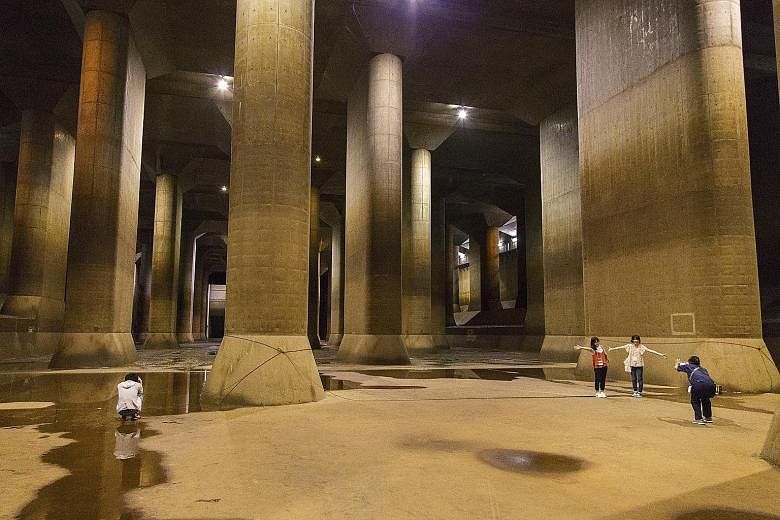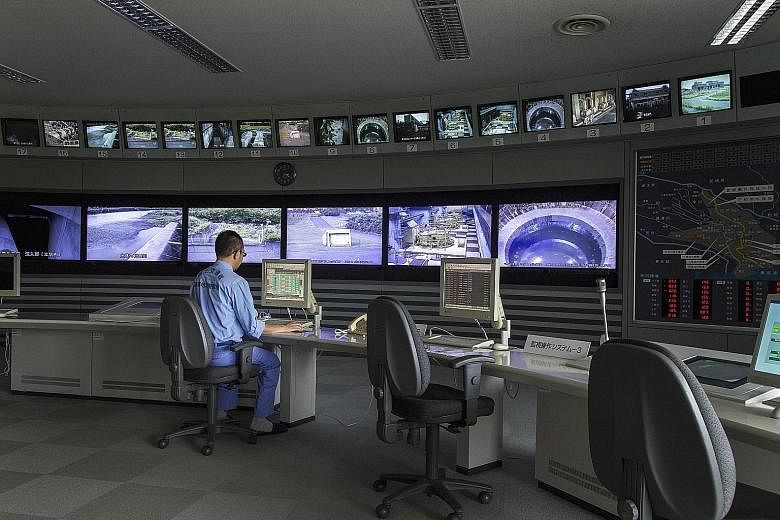KASUKABE (Japan) • The cavernous underground cisterns in Kasukabe, north of Tokyo, could hold the Statue of Liberty, a scale that underscores the site's immense task: protecting the world's most populous metropolis from flooding.
Linked by tunnels that divert water away from the region's most vulnerable floodplains, the US$2 billion (S$2.7 billion) underground anti-flood system, completed in 2006, is an extraordinary example of the defences that global cities are getting ready as they face an era of extreme weather brought on by climate change.
"We're preparing for flooding beyond anything we've seen," said Mr Kuniharu Abe, who heads the underground site. "Until now, at least, we've been successful."
But even in Tokyo, the onset of more frequent and intense storms has forced officials to question whether the region's protections are strong enough, a concern that has become more urgent as the city prepares to host the 2020 Olympic Games.
Rising oceans also make the Tokyo metropolitan region, home to 38 million people, vulnerable to storm surges. Years of pumping groundwater resulted in some parts of the city sinking almost 5m over the past century. Wide areas of Tokyo now sit below sea level, protected by ageing dikes.
Work on the facility in Kasukabe began in the early 1990s, at a time when Japan was pouring funds into huge public works projects. But now, with a government debt more than twice the size of its economy and spiralling costs of caring for an ageing population, the country is less able to muster the resources to fund such ambitious projects.
Even Mr Abe, who runs the Kasukabe site, acknowledged that the sprawling operation may have been a one-time feat. "I'm not sure Japan can build something like this again."
Experts have also questioned the wisdom of erecting more concrete defences in a country that has dammed most of its major river systems and fortified entire shorelines with breakwaters and concrete blocks. Some of these protections, they said, only encourage development in regions that could still be vulnerable to future flooding.
Still, the Kasukabe operation remains a critical part of Tokyo's defences, said officials at Japan's Land Ministry, which runs the site. Five vertical, underground cisterns, almost 76m deep, take in storm water from four rivers north of Tokyo.
A series of tunnels connect the cisterns to a vast tank, larger than a soccer field, with ceilings held up by 18m-tall pillars that give the space a temple-like feel. From that tank, industrial pumps discharge the flood water at a controlled pace into the Edo River, a larger river system that flushes the water into Tokyo Bay.
Between floods, site managers run tours of the facility, inviting members of the public to walk on the floor of the vast tank and to peer into the murky cisterns .
"This is another important role," said Mr Yasuyuki Osa, Mr Abe's deputy, after a recent tour, "to get people to think about the danger of floods, and how we can adapt."
NYTIMES


